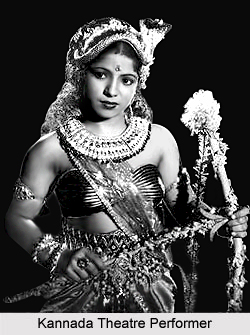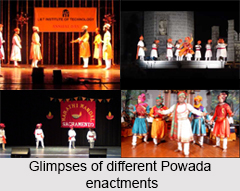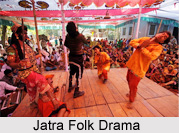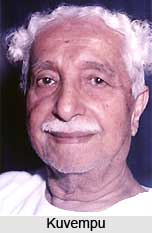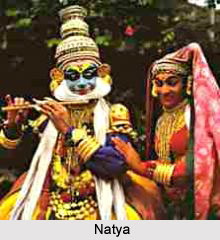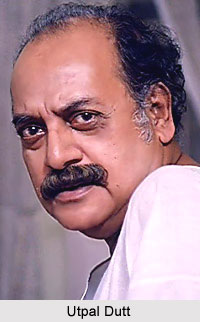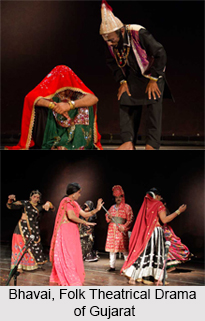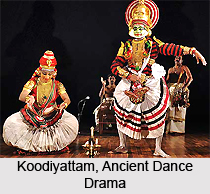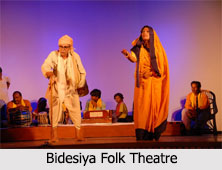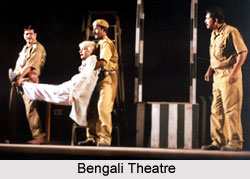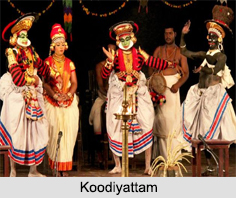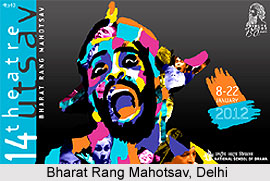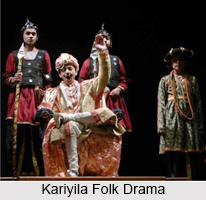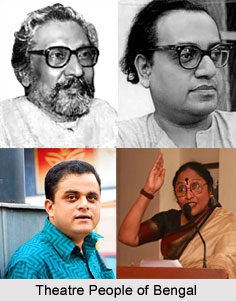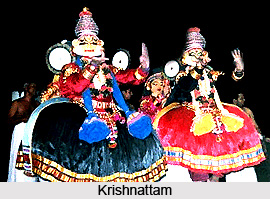 Krishnattam is a traditional form of Sanskrit theatre mainly practiced in the Kerala state of India. The word Krishnattam or Krishnanattam mainly means `Krishna enactment`. It is a kind of dance drama which depicts the story of Krishna in a series of eight plays and was created by Manaveda, the then Zamorin Raja of Calicut in northern Kerala.
Krishnattam is a traditional form of Sanskrit theatre mainly practiced in the Kerala state of India. The word Krishnattam or Krishnanattam mainly means `Krishna enactment`. It is a kind of dance drama which depicts the story of Krishna in a series of eight plays and was created by Manaveda, the then Zamorin Raja of Calicut in northern Kerala.
Evolution of Krishnattam
Its forerunner was the Ashtapadiyattam dance-drama in which local dance and music had established a happy blending. This is based on the Krishna lore and ashtapadis i.e. `eight-verse` songs of Jayadeva`s Sanskrit Gitagovinda. This was mainly done in the twelfth century. This form became extinct, transfiguring its legacy into the new Krishnattam.
In 1653, Manaveda Samutiri composed Krishnagiti i.e. `Krishna Lyrics` in Sanskrit. This was inspired by Jayadeva, presenting Krishna`s whole story in eight parts, with many more characters. The stage rendition of this poem became known as Krishnattam. The eight stories on Krishna`s life can be mentioned as Avataram or his birth as an avatar, Kaliyamardanam i.e. `Kaliya Crushed`, Rasakrida i.e. `Ras Sport`, Kamsavadham i.e. `Slaying of Kamsa`, Svayamvaram i.e. `Choice of Groom`, Banayud-dham i.e. `War with Bana`, Vividavadham i.e. `Slaying of Vivida`, and Svargarohanam i.e. `Ascent to Heaven`.
All these parts are presented over several hours on eight nights in the precincts of the famous Srikrishna temple at Guruvayur, Malappuram district, as a votive offering to the presiding deity by pilgrims. Rich devotees may sponsor performances which are considered a means to attain their prayers. The troupe engaged in this art is the only one of its kind, and maintained by the temple, which gives the actors systematic training from a young age. C. Sankaran Nair exposed this rare art to the rest of India after Independence by taking it on tour outside Kerala.
Costume of Krishnattam
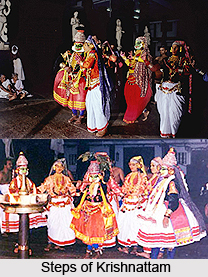 The costumes are generally made by the artists themselves. There is a basic difference in the male and female characters. The male costume comprises of a starched gathered petticoat; a gathered white skirt with orange/orange-red and black horizontal stripes near the bottom; bells attached to leather pads to tie below the knees; a long-sleeved shirt open at the back, secured by ties; a breast-plate; chest ornaments of beads and fresh flora; a girdle; upper arm and wrist ornaments; one shawl or more with a mirror at each end; ear and forehead ornaments; and a headdress.
The costumes are generally made by the artists themselves. There is a basic difference in the male and female characters. The male costume comprises of a starched gathered petticoat; a gathered white skirt with orange/orange-red and black horizontal stripes near the bottom; bells attached to leather pads to tie below the knees; a long-sleeved shirt open at the back, secured by ties; a breast-plate; chest ornaments of beads and fresh flora; a girdle; upper arm and wrist ornaments; one shawl or more with a mirror at each end; ear and forehead ornaments; and a headdress.
The female character wears a long, almost floor-length white gathered skirt with red border, wrapped so that the material crossed in the back; a long sleeved blouse which was open in the back, secured by ties; a girdle; arm ornaments; a wooden breast plate with the breasts covered in red cloth and with ornamentation above and below the breasts. The female characters also tie strings of bells called `chilanka` around their ankles.
The most important and sacred costume of this dance-drama is the head gear. The basic head gears are of two types including mudi and kiriitam.
Similarity with Kathakali
This art is more sophisticated and differentiated compared to Kutiyattam. Krishnattam`s make-up, costumes, and ornaments look similar to those of Kathakali, with striking variations especially in the case of the painted wooden masks used by certain characters. The dance is lyrical and the story communicated through beautiful choreography, using a few hand gestures and facial expressions. Intimate minimalism is the core of the performance, including the simple treatment of vocal music with restrained use of melodic patterns. The meaning of each word in the text is not interpreted in action as in Kathakali. But the total meaning of a passage is conveyed mainly through dance. The graceful coordination, precision, and elegance with which a group of characters moves cannot be seen in any other form of Kerala. This is well illustrated in the story of Rasakrida where Krishna revels with the Gopis. This is mullappuchuttal, literal meaning of which can be mentioned as `going in a circle like jasmine flowers`. This is a brilliant dance in which the performers move with intricate footwork, creating a sense of the flowers being fastened into a garland.
As in Kathakali, two singers stand behind the acting area and the percussionists share space with them. The main vocalist has a gong-like chengila in his hand on which he keeps time with a stick. The chengila is a round alloy of brass, copper, and lead, specially combined to create the sound. The second vocalist uses the elata Lim i.e. a pair of heavy metal cymbals for timing. The accompanying percussion instruments are maddalams and edakka, drums that provide attractive patterns of rhythmic support to the flow of dance.







